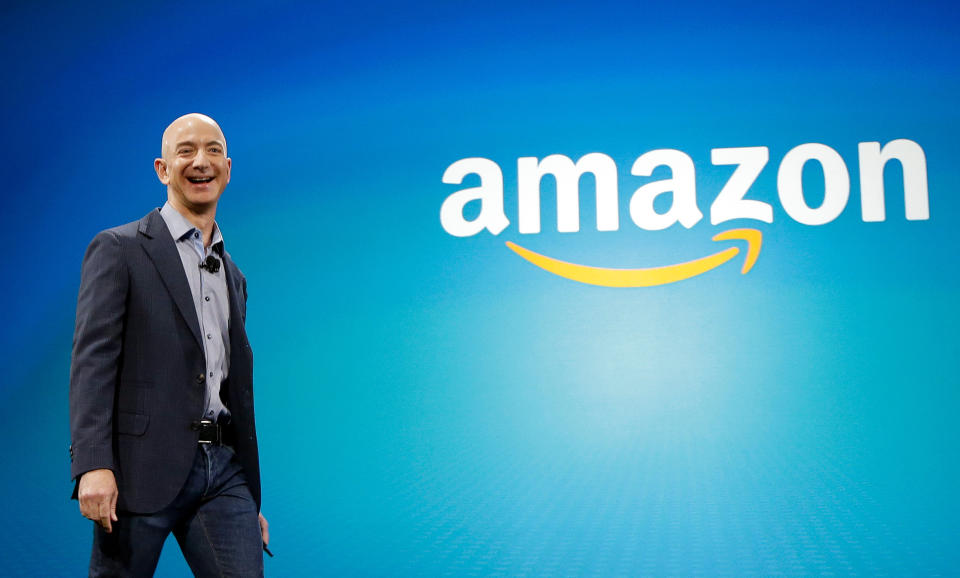Why Amazon will have success selling workout clothes
Amazon (AMZN) has been quietly staffing up to launch its own activewear brand, Re/code reported this week based on “brand manager” job listings at the Seattle-based e-commerce giant. The job posts say Amazon wants to hire people “to build authentic activewear private label brands that have compelling and unique DNA and deliver amazing consumer-valued innovation.”
Activewear typically signals running shorts, yoga pants—all manner of stretchy outerwear made for fitness. And you might have heard it called something else: “athleisure.” (Under Armour CEO Kevin Plank, among many apparel execs, does not appear to love the term.)
If this move by Amazon comes as any surprise, it shouldn’t. The company has been beefing up its apparel business for a few years, and this was an inevitable next step. And while the $44 billion activewear market (according to NPD Group) is overcrowded with players, from Nike, Adidas, and Under Armour to Lululemon and Gap-owned Athleta, Amazon can almost certainly invade the space and have some success.

Amazon will soon be the No. 1 clothing retailer in America
Amazon is already the biggest US clothing retailer online, and has been for a few years. But a report last year from Cowen & Co. predicts that in 2017, it will also become the biggest clothing retailer, period—climbing over brick-and-mortar giants like Macy’s (M), Kohl’s (KSS), and Nordstrom (JWN).
Think about that for a moment: A website launched in 1994 originally as a bookseller became the biggest apparel giant in America—and made it look easy. It’s all about timing: just as Macy’s and Kohl’s are faltering (both reported 2% drops in holiday sales this week, sending their shares plummeting), Amazon is picking up steam. It is “eating the department store,” Bloomberg writes.
In 2015, Amazon sold an estimated $16 billion in clothing and accessories. That amounts to less than 15% of its $107 billion in overall revenue, but that proportion has risen rapidly, and Cowen predicts the figure will grow by 30% this year, reaching $28 billion. For comparison: Nike’s total revenue in 2016 was $32 billion, so Amazon is doing half that just in clothing.
In addition to sales climbing, the total number of items Amazon offers in this category jumped by more than 90% last year. As Re/code observed a year ago, Amazon’s selection of clothing is bigger than the selection at 250 Walmart supercenters.
In other words, Amazon get into workout clothing should raise alarms for Nike, Under Armour, and others, sure, but these companies should already be very aware of Amazon’s aggressive moves into apparel. They’ve likely seen this coming.
It all started with Amazon acquiring shoe retailer Zappos in 2009. (It actually purchased another fashion retailer, Shopbop, three years earlier, but Zappos was arguably the real kickstart.) Zappos not only marked the beginning of Amazon’s clothing ambitions, but it also taught CEO Jeff Bezos the lesson about the value of customer service and shipping ease. If items are easy to return, people are willing to buy things online that in the past they would have wanted to try on in a store, Amazon has proven.
Amazon’s successful sub-brand model
Amazon has been launching its own sub-brands for over a year, so getting into athleisure (or “activewear,” if Amazon would prefer) is simply an obvious next step.
In the last year alone, Amazon launched at least seven new lines, with names like Lark & Ro, Scout + Ro, Franklin & Freeman, James & Erin, and Society New York. It launched a men’s button-down shirt line only available to Amazon Prime members (a savvy way to boost signups for Prime) called Buttoned Down.
Notice anything about those names? You don’t see the word “Amazon” in them. As CNNMoney wrote, “The labels do not give shoppers any clue that they’re Amazon-controled brands.”
And that’s just how Amazon has done it in publishing as well. Amazon launched its own publishing division back in 2009, but it started to heat up in the past few years, and suddenly, as many literary blogs have noted, most of the top-10 best-selling e-books on Amazon each week are from Amazon publishing imprints. But you wouldn’t know it from their names.
Amazon’s “indie” publishing imprints have names like Montlake (its romance division), Two Lions (for children), Skyscape (for teens), Waterfall Crest (Christian books), and Lake Union (historical fiction). For its Kindle First program, which gives Amazon Prime members the chance to get one free e-book per month, the majority of the choices each month are from Amazon’s own imprints.
“I don’t think Amazon is trying to hide anything,” says Nate Hoffelder, editor of the e-book news site The Digital Reader. “I think it has more to do with marketing than trickery.” Indeed: if some book buyers believe they’re getting a title from a charming indie publisher, and not from the big, bad web giant putting brick-and-mortar bookstores out of business, that only benefits Amazon, whether it’s intentionally hiding itself or not.
Expect Amazon to follow a similar strategy with its activewear effort. The company isn’t about to peddle sports bras with the Amazon ‘A’ on them; no one would buy them. It will sell its activewear brand through its website, subtly—and likely successfully.
—
Daniel Roberts is a writer at Yahoo Finance, covering sports business and technology.
Read more:
Amazon crushes earnings expectations thanks to Web Services
Amazon Prime Day is a raw deal for e-book buyers
How baseball’s tech arm got so big that Disney had to have a piece

